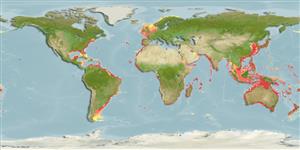Common names from other countries
Environment: milieu / climate zone / depth range / distribution range
Ecología
; rango de profundidad 3 - 120 m (Ref. 81749). Tropical
Circumglobal.
Length at first maturity / Tamaño / Peso / Age
Maturity: Lm ? range ? - ? cm
Epibiotic (Ref. 111011). Occurs in subtidal and low tide areas, and it usually covers bare rocks. Found on a dead branch of A. wollastoni (Ref. 2767). Part of fouling communities attached to raft frames in mariculture zones (Ref. 127121).
Life cycle and mating behavior
Madurez | Reproducción | Puesta | Huevos | Fecundidad | Larva
Members of the superorder Thoracica are mostly hermaphroditic. Broadcast spawners, fertilization occurs in the mantle cavity. Life cycle: Eggs hatch into planktonic nauplii and leave the mantle cavity. Afterwards, they undergo six naupliar instars succeded by nonfeeding cypris larva (settling stage) which later metamorphose into adults.
Young, P.S. 1998. (Ref. 3549)
IUCN Red List Status (Ref. 130435)
CITES status (Ref. 108899)
Not Evaluated
Not Evaluated
Human uses
| FishSource |
Herramientas
Más información
Age/Size
Crecimiento
Length-weight
Length-length
Morfología
Larva
Abundancia
Fuentes de Internet
Estimates based on models
Preferred temperature
(Ref.
115969): 17 - 28.2, mean 26.1 (based on 1668 cells).
Price category
Unknown.
